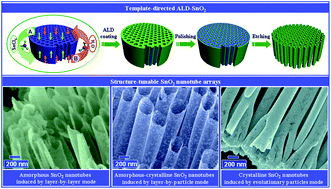Three growth modes and mechanisms for highly structure-tunable SnO2nanotube arrays of template-directed atomic layer deposition†
Abstract
This article presents a vapor-phase strategy to synthesize highly structure-tunable

* Corresponding authors
a
Department of Mechanical and Materials Engineering, The University of Western Ontario, London, ON, Canada
E-mail:
xsun@eng.uwo.ca
This article presents a vapor-phase strategy to synthesize highly structure-tunable

 Please wait while we load your content...
Something went wrong. Try again?
Please wait while we load your content...
Something went wrong. Try again?
X. Meng, Y. Zhang, S. Sun, R. Li and X. Sun, J. Mater. Chem., 2011, 21, 12321 DOI: 10.1039/C1JM11511A
To request permission to reproduce material from this article, please go to the Copyright Clearance Center request page.
If you are an author contributing to an RSC publication, you do not need to request permission provided correct acknowledgement is given.
If you are the author of this article, you do not need to request permission to reproduce figures and diagrams provided correct acknowledgement is given. If you want to reproduce the whole article in a third-party publication (excluding your thesis/dissertation for which permission is not required) please go to the Copyright Clearance Center request page.
Read more about how to correctly acknowledge RSC content.
 Fetching data from CrossRef.
Fetching data from CrossRef.
This may take some time to load.
Loading related content
